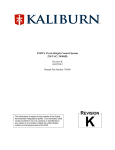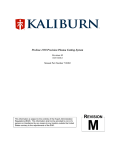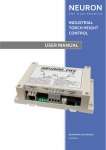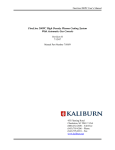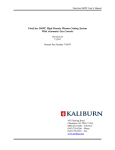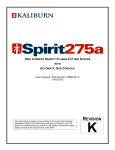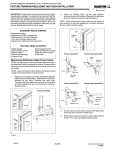Download INOVA Torch Height Control System
Transcript
Overview Inova User’s Manual Functions and Definitions Arc Voltage Control (AVC): This servo system is the most advanced voltage control available. It continuously monitors the arc voltage while cutting, and can respond at speeds up to 600 inches per minute. This rapid response means that arc voltage control is available for high, intermediate, or low speed plasma arc cutting. The servo loop is software controlled with adjustable proportional gain for achieving the desired system response. The arc voltage can be set in increments of .10 arc volts. Initial Pierce Height Setting (IHS): The Inova offers initial pierce height setting capability to any plasma system. The Inova uses a “soft touch” plate sensing technique to set the initial pierce height. For plasma systems that do not have plate sensing capability, a patented motor torque sensing technique is used. The amount of torque, or touch force, is programmable from the optional remote control unit. No external switches or other devices are required for setting the pierce height. Manual positioning can be used if automatic initial height positioning is not desired. Full/Partial Raise: The torch can be programmed to retract to the top of the travel or to a programmable partial raise height at the end of a cut. The partial raise height is adjustable in increments of .001 inches. Pierce Height: The pierce height is the initial piercing height of the torch and is set during the IHS (initial height setting) sequence. Cutting Height: The cutting height is the height the torch is moved to after the pierce time has elapsed and before the AVC mode is activated, in which case the cutting height will be governed by the arc voltage setting. Pierce Time: The pierce time is the delay between the reception of an arc transfer signal (motion signal) from the plasma power supply and the transition of the torch from the pierce height to the cutting height. Crossover Height: The transition from high to low speed during initial height sensing takes place at the crossover height. This height should always be at least two inches above the plate to avoid damaging the torch. Corner: This feature allows the arc voltage control to be disabled while cutting. It is used to prevent the torch from diving into the workpiece during corners, when initially piercing a heavy plate, or any other time the x/y machine speed decreases below the programmed cutting speed. 2-8 Overview Inova User’s Manual Arc Voltage Limiter (Limit): This feature automatically inhibits arc voltage control for a short period of time when the actual arc voltage exceeds the desired arc voltage by 12 volts. As soon as the actual arc voltage is less than 12 volts, the control will resume arc voltage control. This feature helps prevent torch crashes when crossing kerfs or when a cut piece drops away from the plate. IHS Test/Run: IHS run is the normal cutting mode of the system. IHS test allows the initial pierce height of the torch to be checked for proper standoff without starting an arc. Switching from IHS test to IHS run will enable arc starting and proceed normally through a cutting sequence. Cycle Complete: In Auto, a cycle complete contact closure indicates that the torch has reached the correct retract height at the end of a cut. In Manual, the cycle complete contacts are always closed. Automatic Gas Initiation (AGI): The automatic gas initiation feature starts the plasma torch gas preflow during the IHS sequence. The arc hold relay remains closed until the initial pierce height is set, at which time the arc hold relay is released and the arc is initiated. Clear-The-Plate (CTP): The clear-the-plate feature allows the Inova to sense when the torch shield cap, nozzle, or other sensing device has touched the plate. It is used to accurately set the initial pierce height of the torch and is also the basis for the “soft touch” feature. For plasma systems that do not have plate sensing capability, the CTP feature can be turned off. In this case, the motor torque sensing circuit is used for setting the initial pierce height of the torch, with some trade-off in IHS repeatability. Automatic Collision Avoidance (ACA): This safety feature allows the control to automatically adjust the torch height during a cut to help prevent torch crashes. Arc Voltage Delay: The arc voltage delay is the time between a removed corner signal and the resumption of arc voltage control. Retract Delay: The retract delay is the time between a stop command and torch retraction. It should be adjusted so the arc is extinguished before the torch retracts at the end of a cut. Touch Force: The touch force is the force required to initiate torch retract during initial height sensing in the event that the “soft touch” feature is not triggered. The parameter is represented by a relative number between 0 and 200. Larger numbers represent higher touch forces. This setting should be set to the lowest value that reliably sets the initial pierce height of the torch. If the value is too low, the torch will not travel all the way to the plate and the arc will be initiated in the air. 2-9 Overview Inova User’s Manual Arc Hold: The arc hold relay is used in conjunction with the plasma start relay to start the plasma torch gas preflow during the IHS sequence, provided that the automatic gas initiation (AGI) parameter is enabled. When the Inova receives a cycle start command, the plasma start relay closes immediately. The arc hold relay contacts are normally closed and prevent the initiation of the plasma cutting arc. Upon the completion of the IHS cycle, the arc hold relay opens and the plasma arc is ignited. Manual Speed: Manual speed is the speed at which the positioner moves when the control is in the manual mode. Note that in Manual, the positioner moves at a slow speed when the up/down buttons are initially pressed. The speed is increased to the manual speed if the buttons are held down. Slow Inch Down (SID) Speed: Slow inch down speed is the speed at which the positioner travels during the slow speed portion of the IHS cycle. CNC Machine Interface Signals The following cnc machine signals should be present for any machine that does not use an RS-422 communications link to control the Inova console(s). Cycle Start Input: The Inova requires a relay contact closure on this input to start the cutting sequence. Opening the contacts will terminate the cutting cycle. Corner Freeze Input: The Inova requires a relay contact closure on this input to disable arc voltage control during automatic operation. The corner relay contacts should close any time the x/y machine speed decreases below the programmed speed. Partial Raise Enable Input: The Inova requires a relay contact closure on this input to enable the torch to retract to the programmed partial raise height. Opening the contacts disables the partial raise feature and causes the torch to retract to the full raise position. Disabling the partial raise feature is useful when the x/y machine traverses across large distances. If this signal is not used, switch SW4-3 (x/y raise disable) should be switched to the “on” position. Motion Output: The Inova provides a relay contact closure on this output when the arc transfer signal has been received from the plasma power supply. Cycle Complete Output: In Auto, the Inova provides a relay contact closure on this output when the torch has retracted to the programmed raise height at the end of a cut. The contacts are always closed in the Manual mode. 2-10



